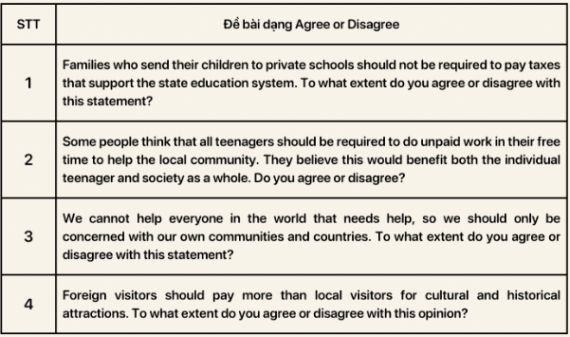Agree or Disagree | Bài mẫu IELTS Writing Task 2 Agree or Disagree
Giới thiệu về dạng IELTS Writing Task 2 Agree or Disagree
1. Dạng bài Agree or Disagree là gì?
IELTS Writing Task 2 Agree or Disagree là dạng bài yêu cầu bạn phải đưa ra quan điểm cá nhân đồng ý hay không đồng ý sau khi đề đã cung cấp một nhận định hay ý kiến trái chiều nào đó, đồng thời đưa ra những lập luận, lý do, thông tin để giải thích.
2. Dấu hiệu nhận biết
Với dạng Agree or Disagree, đề bài thường có 2 phần: Phần 1 là luận điểm/quan điểm về một vấn đề cụ thể’ Phần 2 là câu hỏi có dạng như sau:
- Do you agree or disagree?
- What is your opinion?
- To what extent or disagree?

3. Cấu trúc viết bài dạng Agree or Disagree
Một bài mẫu IELTS Writing Task 2 Agree or Disagree bao gồm các phần như sau:
3.1. Introduction (Mở bài)
Mục đích của đoạn mở bài là trả lời câu hỏi và thể hiện quan điểm của bạn (đồng ý, không đồng ý hay đồng ý một phần) cho vấn đề nhất định của bài.
3.2. Body
Phần thân bài là nơi để bạn trình bày các lập luận của mình kèm theo ví dụ chứng minh. Thông thường một bài mẫu IELTS Writing Task 2 Agree or Disagree bạn chỉ cần triển khai 2 luận điểm ứng với 2 đoạn văn.
- Nếu câu trả lời của bạn đưa ra là đồng ý/không đồng ý, lập luận của bạn phải rõ ràng và đủ hợp lý để người đọc hiểu tại sao bạn lại lựa chọn như vậy.
- Nếu câu trả lời của bạn là đồng ý một phần, bạn phải nêu rõ bạn đồng ý hay không đồng ý ở điểm nào. Mọi lập luận phải có giải thích cụ thể và ví dụ rõ ràng.
3.3. Conclusion
Tại phần kết luận của một bài mẫu IELTS Writing Task 2 Agree or Disagree. Bạn cần khẳng định lại quan điểm của mình và giải thích ngắn gọn. Đoạn kết luận thường chỉ khoảng 1-3 câu.
4. Một số lưu ý khi viết bài:
- Bài thi Writing Task 2 agree or disagree trong IELTS yêu cầu bạn viết tối thiểu 250 từ, nên hãy lưu ý viết đủ hoặc hơn để không bị trừ điểm.
- Bạn nên thể hiện rõ lập trường của mình ở phần Mở bài hoặc phần Kết bài của bài viết IELTS Writing Task 2 agree or disagree thì bài viết của bạn sẽ có tính thuyết phục hơn.
Các bài mẫu IELTS Writing Task 2 Agree or Disagree
Hãy cùng tham khảo một số bài mẫu IELTS Writing Task 2 Agree or Disagree band điểm cao sau đây nhé!
1. Bài mẫu IELTS Writing Task 2 Agree or Disagree: Work motivation
Đề bài: Many factors motivate people in the workplace. Of these, money is the most important. To what extent do you agree or disagree?
Bài mẫu:
At the workplace, people have various motivations to make them work harder. Some argue that money is the most impactful driver. I respectfully disagree with this opinion for several reasons.
It would, however ,be necessary to examine why money could be an important incentive first. Money is obviously essential for people’s livelihoods, since they cannot afford necessities without it. However, enough money to sustain is not merely satisfactory for many, as they desire more money from work. Extra income will allow them to purchase luxuries and display their status to others. For people who come from a different and less well-off area, money will definitely be on top of their list of priorities. Given the possibilities that earning large amounts of money enables, it is hardly surprising that financial motivation accounts for a large part of what drives people to work hard.
Yet, despite these points, there still exist factors that can motivate people harder than money does, making money possibly not the most important factor. One of them is the social environment at the workplace. Secondly, it’s passion for the job. Finally, and most crucially , it’s belief in the purpose. Take politics for example.
In conclusion, I believe that money is not the most important factor which motivates people at work, since there are factors that are more important.
Từ vựng mới trong bài mẫu IELTS Writing Task 2 Agree or Disagree Work motivation:
- display the status: thể hiện địa vị
- well-off area: khu vực/tầng lớp khá giả
- earning large amounts of money: kiếm được nhiều tiền
- financial motivation: động lực tài chính
- passion for: niềm đam mê với
2. Bài mẫu IELTS Writing Task 2 Agree or Disagree: Patriotism
Đề bài: Some people say patriotism is the biggest cause of war. But others believe that when people are patriotic, they are more likely to take an interest in a country’s day-to-today running and therefore less likely to allow unscrupulous politicians to drive a country to war. To what extent do you agree or disagree?
Bài mẫu IELTS Writing Task 2 Agree or Disagree Patriotism:
Patriotism, according to some, is the chief cause leading to conflict and strife across the globe. This view, however, is contradicted by a belief that patriots are a net benefit to their own country, as the more interested they are in the country’s affairs, the more they are able to avert unconscionable wars. In taking both perspectives into account, I find myself strongly leaning toward the latter outlook.
It is not without proof that patriotism is the major element to war; evidence for this claim, in fact, is abundant, thanks to the pervasiveness of war propaganda which appeals to patriotism. Napoleon, in his quest to put Europe under French dominion, propagandized himself as a populistic figure who was performing patriotic duty to France by delivering peace and stability to the country. His nephew, Napoleon III, later started an ill – fated war against Prussia after promising the patriotic population that victory would restore France’s glory. Through these historical precedents, it is understandable that national devotion could be blamed for warfare.
Nevertheless, patriotism should not be perceived as a precursor to war, for I argue that passion for one own’s country might even have the opposite effect regarding conflict. When motivated by patriotism, people would want to improve their country’s standing and its spirit, but to fundamentally affect the issues that matter to their homeland, one would have to be involved in the country’s day – to – day workings. Consequently, the logical conclusion expected from patriotic people is that as peace facilitates carrying out their objectives, they would need to develop a cautious attitude toward warfare.
This vigilance, in turn, will be of help in resisting reckless calls to war from irresponsible politicians. Many of the most hawkish calls to war are hardly motivated by loyalty; instead, they come from special interest groups who would stand to profit the most from conflict, financially or politically. These groups are capable of claiming any cause to advocate for hostilities, and patriotism just so happens to be the easiest sense to invoke in the common folk. The only way to render these warmongers powerless, is to have people who have honest intentions for the country involved in the process of governance, where they would be able to keep jingoistic voices in check.
In conclusion, patriotism is not a force for war, but rather, one which can be harnessed against unscrupulous hostile action. It is my belief, therefore, that the patriotic’s interest in their own country’s agendas be encouraged and supported.
Từ vựng mới trong bài mẫu IELTS Writing Task 2 Agree or Disagree Patriotism:
- unconscionable war: cuộc chiến tranh phi chính nghĩa
- appeal to patriotism: kêu gọi lòng yêu nước
- blamed for something: đổ lỗi cho
- country’s standing: vị thế của đất nước
- be motivated by: được thúc đẩy bởi
- invoke in the common folk: khơi dậy trong công chúng
- the process of governance: quá trình quản trị
3. Bài mẫu IELTS Writing Task 2 Agree or Disagree: Travel
Đề bài: Internet technology means people do not need to travel to foreign countries to understand how others live. To what extent do you agree or disagree?
Bài mẫu IELTS Writing Task 2 Agree or Disagree Travel:
In this day and age, the Internet has pushed back the frontier of human impossibilities in a multitude of spheres including traveling. This deep infiltration into the tourism industry makes some people declare that the Internet has turned traveling abroad into an obsolete choice. Nevertheless, from my standpoint, traveling in person still retains its values in the technology-driven era.
Admittedly, the Internet tremendously facilitates the demand for overseas traveling of time-poor or not-so-wealthy people. Modern people are usually characterized as work obsessives so their hectic working schedule will certainly be a huge hurdle to their traveling desire. Also, some people may find it difficult to afford an enjoyable overseas journey due to their lack of financial resources. In these cases, the Internet emerges as an ideal tool to help these people quench their thirst for going on vacation and having horizon-broadening experiences about foreign cultures. For instance, people can search on Youtube for a wide range of documentaries about indigenous cultures in remote areas like the Amazon forest, African jungles from international broadcasting channels such as Discovery or National Geographic.
However, I still attach myself to the position that the Internet cannot replace physical traveling. This is because only by traveling directly to another country can people acquire first – hand experience and appreciate foreign cultures to the full. Due to the lack of physical interaction, no matter how the virtual traveling experience from the Internet progresses, it pales in comparison with the first – hand experience when going to a foreign country. What is also worth contemplating is the quality guarantee of online information. Internet information about tourism may be presented in a distorted or biased way for entertainment purposes, which cannot paint a complete picture of the foreign lifestyle. Therefore, when going to other countries in person, travelers are able to see exotic cultures through their own spectacles and have more proactive acquisition of knowledge about different ways of life around the world. To exemplify, South Korea is often depicted in social media as a wealthy and highly civilized country. However, traveling directly there allows visitors to acknowledge certain dark spots in its society namely domestic violence and gender disparity, which is a fuller and more objective picture of this Asian nation.
In conclusion, even though the Internet can serve as a great traveling assistant for some people, traveling to other countries in person is still an unparalleled option in terms of the experience it offers. Hence, travel enthusiasts can flexibly choose either form of traveling but if given the chance, should go abroad directly to make the most out of traveling.
Từ vựng mới trong bài mẫu IELTS Writing Task 2 Agree or Disagree Travel:
push back the frontier: đẩy lùi ranh giới
tourism industry: ngành du lịch
demand for something: nhu cầu cho điều gì
traveling desire: mong muốn đi du lịch
thirst for something: giải tỏa mong muốn/khát vọng làm gì
have horizon-broadening: mở rộng chân trời
international broadcasting channels: kênh truyền hình quốc tế
foreign culture: nền văn hóa của quốc gia khác
exotic culture: nền văn hóa kỳ lạ
highly civilized country: quốc gia văn minh cao
domestic violence: bạo lực gia đình
gender disparity: chênh lệch giới tính
4. Bài mẫu IELTS Writing Task 2 Agree or Disagree: Solving transportation problems
Đề bài: The best way to solve the traffic and transportation problem is to encourage people to live in cities rather than suburbs or countryside. Do you agree or disagree?
Bài mẫu IELTS Writing Task 2 Agree or Disagree:
The issue of traffic and transportation is a ubiquitous concern in numerous cities worldwide. The prevalent argument suggests that encouraging individuals to live in cities, rather than suburbs or rural areas, is the optimal solution to tackle this issue. While this proposal possesses certain advantages, it fails to provide the best possible outcome.
On the one hand, many individuals advocate for urban living as an ideal means to reduce traffic. This is primarily due to the fact that it would reduce traffic on roads by promoting alternative modes of transportation such as walking, cycling, and public transportation, which are more readily available and convenient in urban areas. This, in turn, would result in fewer cars on the road, less traffic congestion, and a reduction in air pollution caused by automobiles.
On the other hand, resorting to urban living as a means to reduce traffic jams is overly simplistic. This argument overlooks the reality that cities are already overpopulated and the increased population density could put more strain on the transportation infrastructure, exacerbating the existing traffic problems. Moreover, with the influx of people, it would reduce the quality of life for those already residing in cities due to the scarcity of resources and space.
To conclude, although encouraging individuals to reside in cities may lessen the traffic on roads, it is not the optimal solution to the traffic and transportation problem. This is because it would result in cities becoming overpopulated. Therefore, alternative solutions should be explored to effectively address this issue.
5. Bài mẫu IELTS Writing Task 2 Agree or Disagree: Legal age for driving
Đề bài: Some people think that the best way to improve road safety is to increase the minimum legal age for driving a car or motorbike. To what extent do you agree or disagree?
Bài mẫu IELTS Writing Task 2 Agree or Disagree Legal age for driving:
Road safety is often a topic worth concern because it is directly related to the number of fatalities and injuries caused by traffic accidents. While increasing the minimum legal age for driving motor vehicles has been touted as the optimal solution to improving road safety, there exist other measures which can disprove this statement.
Raising the minimum driving age can achieve some goals, one of which is reducing the number of inexperienced drivers. It could be argued that young drivers tend to be less familiar with participating in traffic than average, so they are more prone to being involved in safety incidents. If such a policy is introduced, the youth would have more time to study traffic laws before they become full-fledged drivers. In the long run, the population’s proficiency in navigating the road is likely to rise, reducing the probability of unfortunate incidents further. Given these points, it is not difficult to understand the praise for increasing the minimum driving age.
However, requiring young people to wait a few more years before being allowed to drive is overshadowed by other measures. Restricting the type of vehicles operated based on age, which is a possible course of action, can reduce traffic hazards without hampering young people’s access to motor vehicles. In Vietnam, for instance, while it is legal to drive at 16 years old, people under 18 are prohibited from operating anything more powerful than a 50cc motorcycle. Moreover, the government can require schools to introduce mandatory traffic safety courses in the curriculum. Safety lessons in civic education could work just as well, as either option addresses young people’s inexperience, a concern which has led to a need for an increased driving age in the first place.
In conclusion, while reasons exist to advocate for a higher minimum driving age, I do not believe that this policy is the most consequential to road safety. To effectively tackle traffic hazards, it will be wiser to consider other options.
Từ vựng ăn điểm được sử dụng trong bài mẫu:
Fatality (n.): thiệt mạng
Touted (adj.): được ca ngợi
Optimal (adj.): tối ưu
Disprove (v.): bác bỏ
Prone to sth (adj.): có xu hướng gặp điều gì đó
Full-fledged (adj.): hoàn thiện
Proficiency (n.): sự thuần thục
Navigate sth (v.): di chuyển qua/trên môi trường nào đó
Probability (n.): xác suất
Praise (n.): lời khen ngợi
Overshadow sth (v.): làm lu mờ điều gì đó
Course of action (n.): phương hướng hành động
Hazard (n.): mối nguy hiểm
Hamper sth (v.): ngăn trở điều gì đó
Civic education (n.): giáo dục công dân
Advocate (v.): ủng hộ
Consequential (adj.): hiệu quả
6. Bài mẫu IELTS Writing Task 2 Agree or Disagree: Education
Đề bài: The typical teaching situation of a teacher and students in the class will not exist by the year 2050. To what extent do you agree or disagree?
Bài mẫu IELTS Writing Task 2 Agree or Disagree Education:
The teaching environment in the classroom is rapidly changing due to the emergence of new technologies. Some have predicted that by the year 2050, the model where teachers and students are required to be present in the same room will cease to exist. However, I am highly skeptical of this prediction’s veracity.
It could be argued that such a forecast arose due to technology’s impact on education. The introduction of online learning platforms, for one, has enabled students to access educational resources regardless of location. While allowing learners to acquire knowledge at their own pace, this development has the side effect of making teachers’ physical presence redundant. Another impact made by technological advancement is related to using artificial intelligence to dispense feedback to students. As A.I.-powered machines can assess learner progress and provide personalized instruction with astonishing accuracy, some people have questioned the point of having teachers. If these arguments were to be taken at face value, one could believe that the teacher-student classroom, as traditionally understood, is under threat.
However, it is unlikely that the traditional teaching environment will completely disappear by the year 2050. This model remains a necessity in certain fields, one of which is children’s education, as students are still at the stage of shaping their concept of the world. Giving a child an education where they never perceive their teachers’ tangibility is likely to warp their understanding of reality. Additionally, having the educator and the learner physically present enables effective interaction between these people. For skills such as trades, having a human teacher in the classroom, who can produce hands-on demonstrations, does wonders for students’ progress. Hence, the teacher-student classroom still provides many benefits that technological novelties are hardly able to replicate.
In my opinion, the prediction for the traditional teaching environment to vanish by the year 2050 is simply not credible. While I do not doubt that this model may evolve, it is ultimately indispensable.
Từ vựng ăn điểm sử dụng:
- Emergence (n.): sự xuất hiện
- Model (n.): mô hình
- Cease (v.): ngừng
- Veracity (n.): sự chính xác
- Skeptical of sth (adj.): nghi ngờ điều gì đó
- Forecast (n.): lời dự báo
- Make sth redundant (v.): làm cho điều gì đó không còn cần thiết nữa
- Dispense sth (v.): cung cấp điều gì đó
- Feedback (n.): lời phản hồi
- Astonishing (adj.): đáng kinh ngạc
- Take sth at face value (v.): chấp nhận điều gì đó là đúng mà không bàn cãi
- Shape sth (v.): định hình điều gì đó
- Concept (n.): khái niệm
- Perceive sth (v.): nhận thức được điều gì đó
- Tangibility (n.): sự hữu hình
- Warp sth (v.): làm biến dạng điều gì đó
- Reality (n.): thực tại
- Trade (n.): nghề
- Hands-on (adj.): trực tiếp
- Technological novelty (n.): thành tựu công nghệ mới
- Replicate sth (v.): bắt chước điều gì đó
- Indispensable (adj.): không thể thiếu
7. Bài mẫu IELTS Writing Task 2 Agree or Disagree: Advertisement
Đề bài: Consumers are faced with increasing numbers of advertisements from competing companies. To what extent do you think are consumers influenced by advertisements?
Bài mẫu IELTS Writing Task 2 Agree or Disagree Advertisement:
In modern life, consumers are frequently exposed to a variety of ads from the industry’s competing agencies, with the extent of advertisements’ influence on consumer behavior up for debate. Despite opinions supporting the contrary, I am inclined to agree that advertisements’ impact on customers’ response is profound and far-reaching.
For some, advertising’s influence is considered insignificant, or at least not as consequential as other factors are. A straightforward line of thought is that one may purchase something because of a specific need and not because of seeing an advertisement. In fact, this would apply to a large number of consumers’ decisions. Additionally, word-of-mouth may be another effective mechanism at driving purchases. People are highly likely to buy a product if a friend or family member recommends it to them. Because of these factors, it may be easy to dismiss the impact that advertisements have.
In reality, evidence points otherwise. Advertising can shape purchasing behavior by creating an emotional connection with consumers, drawing attention to the products in the process. Coca-Cola, for instance, once launched a promotional campaign by selling Coke bottles with people’s names on the label. This appeal to the masses’ sense of individuality and connectivity was an overnight success, as Coke managed to attract waves of sales from people who want to find their names and the names of those they care about. Furthermore, advertisements can tap into a generational desire to overcome geographical limits, deliver the message, and ultimately, the results. In the early 2000s, Apple launched a commercial where its product, the Mac, was anthropomorphized as a laid-back, easygoing millennial while its competitor, the PC, was represented by a serious, yet unassuming office worker. This campaign catapulted the Mac’s brand recognition across the world, and drove Apple’s market share upwards.
In my opinion, it is clear that advertisements have a powerful impact on consumer behavior. Such impact may be translated into either increased sales from existing customers or completely new markets.
Từ vựng ăn điểm sử dụng :
Exposed to sth (adj.): tiếp xúc với điều gì đó
Profound (adj.): sâu sắc
Far-reaching (adj.): ảnh hưởng vươn xa
Consequential (adj.): có hiệu quả
Straightforward (adj.): thẳng thắn
Word-of-mouth (n.): lời truyền miệng
Mechanism (n.): cơ chế
Drive sth (v.): thúc đẩy điều gì đó
Dismiss sth (v.): coi nhẹ điều gì đó
Otherwise (v.): theo chiều hướng ngược lại
Shape sth (v.): định hình điều gì đó
Promotional campaign (n.): chiến dịch quảng cáo
Masses (n.): đại chúng
Overnight success (n.): thành công nhanh chóng
Tap into sth (v.): tận dụng điều gì đó
Geographical limits (n.): giới hạn địa lý
Anthropomorphize sth (v.): nhân cách hóa điều gì đó
Unassuming (adj.): giản dị
Catapult sth (v.): làm tăng vọt điều gì đó
Brand recognition (n.): nhận diện thương hiệu
Translate sth into sth (v.): chuyển hóa một điều thành điều khác
Xem thêm các tài liệu Tiếng Anh hay, chi tiết khác:
TOP Việc làm "HOT" dành cho sinh viên:




